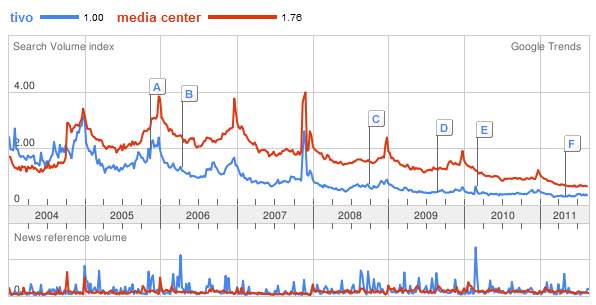The decline and fall of TiVo and Media Center

When you think of DVRs, what’s the first name that comes to mind? TiVo, probably.
TiVo defined the DVR category around the turn of the century, and today the product name has been turned into a verb. If you’re going to record a TV program on your cable company’s DVR, you probably just say you’ll “TiVo it.”*
But name recognition doesn’t pay the bills. The TiVo product line is in a steep decline, a victim of fundamental shifts in digital media technology today. Those same trends explain why Microsoft has shifted Windows Media Center into legacy mode beginning with Windows 8.
Yesterday, Microsoft’s Steven Sinofsky announced that the company was “completely committed to delivering Media Center in Windows 8.” But he also delivered some bracing numbers to Media Center enthusiasts. Based on Microsoft’s telemetry data, roughly 6% of Windows 7 users in July launched Media Center. “However,” he added, “most people are just looking around; only one quarter (25% of 6%) of these people used it for more than 10 minutes per session…”
By my back-of-the-envelope calculations, that 25% of 6% adds up to about 6 million people. Add in Windows Vista users and those still using Windows XP Media Center Edition 2005, assume a wide margin of error, and I think you can safely estimate that 4-8 million people worldwide use some version of Windows Media Center with regularity.
So how does that compare to TiVo? In its most recent SEC filing, TiVo said “As of April 30, 2011, there were approximately 2.0 million subscriptions to the TiVo service.”
In other words, the user base for Media Center is at least twice that of TiVo: 4 million or so versus 2 million. (I assume Google TV usage is measured in the low hundreds of thousands or less, even if you include the Sage TV user base they acquired earlier this year.)
Those numbers are small, and they’re heading in the wrong direction. TiVo’s subscriber base in October 2010 was 2.3 million. It dropped 13% in the six months ending April 2011. And a survey of TiVo’s annual reports suggests that subscriptions peaked in 2007 at 4.4 million and have been declining steadily ever since.
A side-by-side look at the terms TiVo and Media Center in Google Trends shows the rise and fall of both technologies over the past decade:
Indeed, there's a big spike at the end of 2007, followed by a steady and steep decline.
What happened? If you add the term Netflix to that list, you get a completely different Google Trends chart that explains everything:
You could not ask for a clearer trend line: The streaming media era began in 2008, and the DVR is an endangered species.
Update: A few more details to drive the point home:
Both TiVo and Netflix were founded in 1997. At the end of 2004, Netflix had 2.6 million subscribers, roughly the same number as TiVo. At the end of 2007, when TiVo hit its peak of 4.4 million, Netflix had approximately 7.5 million subscribers. As of mid 2011, Netflix has approximately 25 million paid subscribers while TiVo has dropped to 2 million.
In other words, TiVo in 2011 has fewer subscribers than it did in 2004. Netflix over the same period has increased its paying user base by tenfold.
Given those factors, Microsoft has correctly declared Media Center a legacy application. Yes, enthusiasts will be able to use Media Center on Windows 8, but I don’t expect any significant new features, nor do I expect the interface to change from what is currently in Windows 7. Microsoft disbanded the Media Center team after the release of Windows 7 and dispersed those engineers and designers and testers into the teams working on Windows Phone 7, the Zune/Xbox marketplaces, and new digital media experiences in Windows 8.
In Windows 7, Media Center was listed as one of the main feature teams. For Windows 8, that team is gone, and a new Apps and Media Experience team is in place.
With the tremendous success of the Xbox 360, Microsoft actually has a tremendous opportunity to succeed with a digital media marketplace that works in similar fashion with its installed base of Xbox consoles and Windows PCs—especially the next generation of tablet devices running Windows 8.
Microsoft is fortunate that it can pivot away from its DVR-centric Media Center technology to a more inclusive media platform. TiVo doesn’t have that luxury.
In fact, if you want to know where TiVo is likely to end up, consider the $300 million they collected as part of a successful patent-infringement lawsuit against EchoStar for its Dish satellite technology. EchoStar will pay TiVo another $200 million in installments over the next six years.
TiVo intends to step up its patent litigation, based on this statement from its most recent annual filing with the SEC.
In fiscal year ending January 31, 2012, we will continue our efforts to protect our technological innovations and intellectual property. As a result, we expect our litigation expenses for our ongoing patent infringement lawsuits, which include our ongoing litigation with Dish (EchoStar) as well as our lawsuits involving AT&T, Verizon, and Microsoft, to increase significantly from our most recent fiscal year ended January 31, 2011.
Given the current inflated market in patents, I wouldn’t be surprised to see Google or Microsoft pay a hefty premium to acquire TiVo—if only for its solid gold brand name and its market-tested patent portfolio.
* Note to TiVo lawyers: I do not condone or recommend the use of TiVo as a verb.
